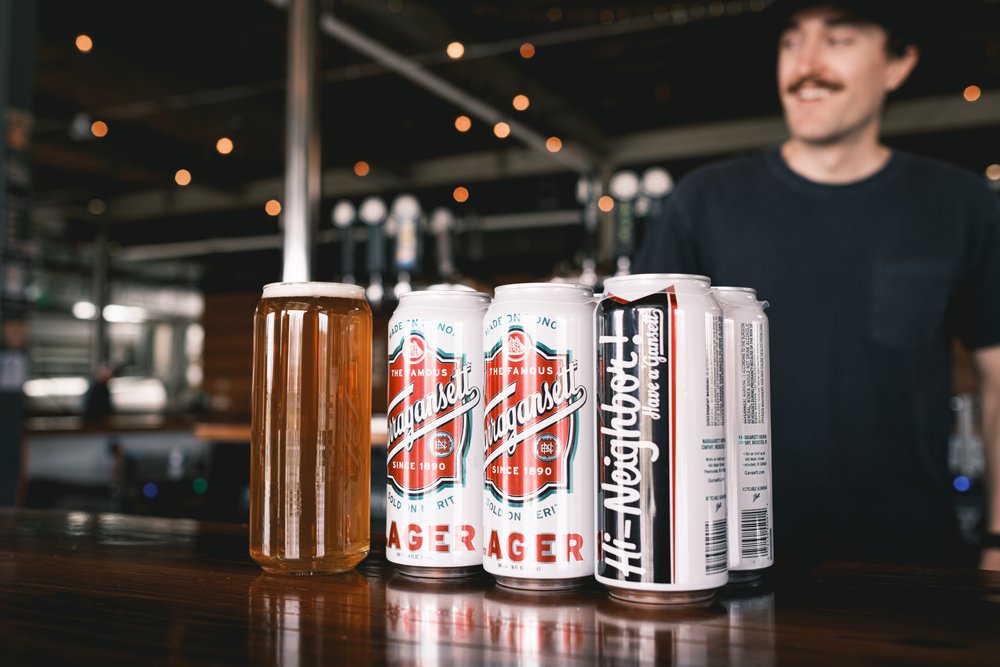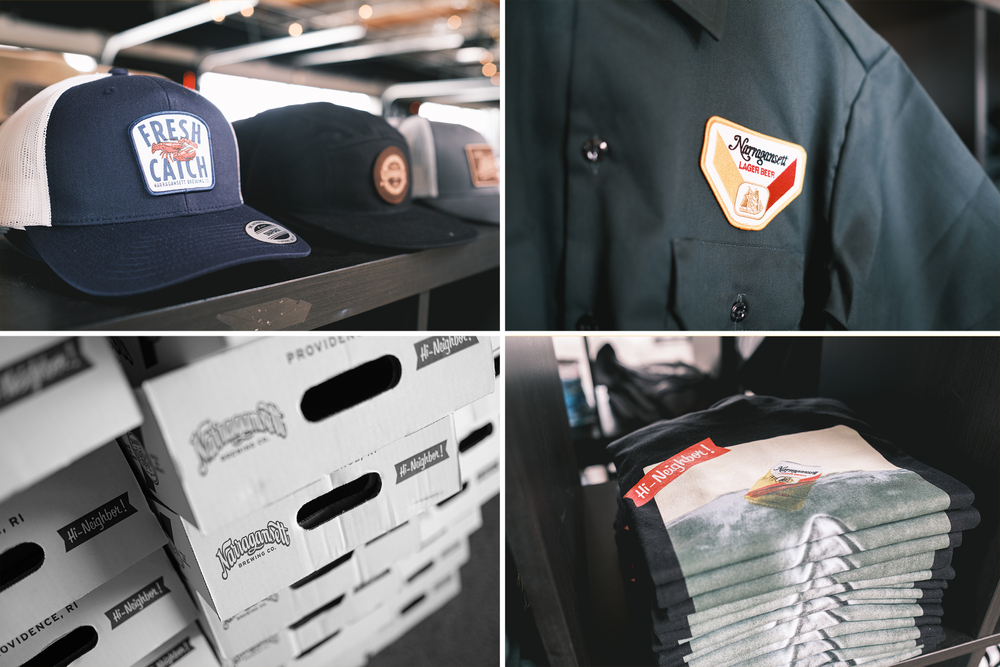
Robert Shaw was a brilliant English actor. As a member of what was then the Shakespeare Memorial Theatre in Stratford-upon-Avon, he appeared in productions of “Macbeth,” “Henry VIII,” “Cymbeline,” and other plays. His acting chops earned him roles on Broadway and in films alongside the likes of Audrey Hepburn and Sean Connery, and he was nominated for Academy Awards and Golden Globes for his performance in “A Man for All Seasons.”

Shaw is perhaps best known, however, for his role as the salty shark hunter Quint in the 1975 thriller “Jaws.” Shaw’s character utters—or maybe more appropriately slurs—many quotable lines in the film, but it’s one scene in particular that endures the test of time.

As the Orca rocks out to sea to try and find the shark that has been terrorizing Amity, Quint asks Chief Brody (played by Roy Scheider) to chum another line. He rocks back in his seat, pops the tab off a Lager, swigs the whole can in a few strong gulps, then crushes it in a show of intimidation. In just 26 seconds, Shaw’s character inspired a movement to #CrushItLikeQuint, led by a brand of beer whose New England roots go almost as deep as the boating industry that’s depicted in that quintessential summer movie. That brand is Narragansett.
LAGER IS THE BEST MEDICINE
Narragansett was born of a confluence of circumstances, including growing rates of urban living, improved brewing technology and scientific understanding, and a wave of German immigration to the United States in the second half of the 19th century. For those who were newly arrived and who craved the Lagers of their homeland, there weren’t many domestic options—at least not initially. In 1890, six German immigrants chose Rhode Island as their ground zero, and founded Narragansett Brewing Company.

By the turn of the 20th century, the company was the biggest beer seller in all of New England, and was consumed mostly in taverns across the region.
“Narragansett was consumed at bars and taverns significantly more than today,” says Mark Hellendrung, the CEO of Narragansett Brewing Company. “It was customary for workers to head to the tavern after work for a few pints, and I’m talking three shifts of workers.”
Lager was also drunk—even prescribed—domestically. In an advertisement in the 1893 R.I. Medical Science Monthly, the beer was touted as a healthful tonic: “Physicians all over New England who have occasioned to prescribe Lager as an invigorator appreciate the fact that the Lager brewed at Narragansett Brewery of Providence … has enabled them to obtain a truly pure and decidedly wholesome beer for their patients.”

However the beer was consumed, its spread seemed irrevocable. The brewery tapped into expanding railway lines to bring its Lager down to bars in New York City, which, according to Hellendrung, is likely as far as the beer traveled in those days. Before the 18th Amendment struck down alcohol production in 1919, the brewery was pumping out around 300,000 barrels of beer a year. During Prohibition, the brand stayed alive by selling ice, non-alcoholic drinks, and a Narragansett Malt Extract that promised to reinvigorate patients and enrich their blood.
It took two weeks after Franklin Roosevelt signed the 21st Amendment before the wort began bubbling again. A canning line was installed in 1935. Narragansett was, once again, able to welcome guests, and get its beer on shelves across Rhode Island and New England.

In the 1940s, Narragansett teamed up with a New England cartoonist named Theodor Geisel, who went on to pen, under the Dr. Seuss nom de plume, canonical works of children’s literature. Geisel created the Chief Narragansett character for ad campaigns. The cringeworthy depiction of a Native American stereotype adorned some advertising materials, and ultimately was not used on any cans.
By the middle of the 20th century, the brewery had expanded greatly. The company was purchased by Rudolph Haffenreffer Jr., a Boston-born philanthropist and businessman, who took on a leadership position. “This was a period of explosive growth,” says Hellendrung. “Securing its water source with the Scituate Reservoir, investing in the brewery, and the beginning of the iconic ‘Hi Neighbor, Have a ’Gansett’ campaign.”

For Narragansett, part of becoming a regional powerhouse also meant inking a first-of-its-kind sports media partnership. It was a deal that helped establish a deep-rooted connection that would resonate locally for generations.
BALLPARKS AND BEER
Baseball and beer have been inextricably linked since the sport’s infancy. Beer sales in the American Association (1882-1891) helped fuel the league’s ascent; the combination of cheap tickets and beer concessions, and the backing of brewery and distillery owners, earned the league the nickname “The Beer and Whiskey League.” This kinship has endured partly because of the romanticism associated with a cold beer on a sun-soaked summer afternoon in a bleacher seat, but also because it is a lucrative concession.

Before the cozy, cushioned seats of a publicly owned and funded baseball viewing experience, the Red Sox partnered with Narragansett. It was a partnership that lasted more than 30 years, from 1944 to 1975, and was the heyday for the brewery.
It also helped launch the career of a sporting legend. Curt Gowdy was an icon in American sports broadcasting; in his half-century career, Gowdy called the Super Bowl, Olympic Games, World Series, and covered everything from college basketball to a long-running ABC broadcast called “The American Sportsman.” But before all that, he was the voice of the Boston Red Sox. He passed away in 2006.
He would do these live beer commercials. I’d go to the booth with him to watch him broadcast. He would, in the middle innings, do a live spot. ‘Hi Neighbor! Have a ’Gansett,’ crack a beer open, and hold up a glass and toast the audience. Then the next inning would begin.
“My dad was beloved,” says Curt Gowdy Jr., who recently retired as the senior vice president at SportsNet New York. “I used to love to tag along with him at Fenway Park.”

Every broadcast during Gowdy’s 15-season tenure with the Red Sox included a familiar refrain. “He would do these live beer commercials,” Gowdy Jr. remembers. “I’d go to the booth with him to watch him broadcast. He would, in the middle innings, do a live spot. ‘Hi Neighbor! Have a ’Gansett,’ crack a beer open, and hold up a glass and toast the audience. Then the next inning would begin.”
Despite an initial drift away, that slogan now lives on bumper stickers, billboards, and, in some cases, permanently on the bodies of brave beer drinkers.
The elder Gowdy wasn’t much of a beer drinker, says his son, but that didn’t prevent the Narragansett team from keeping him in beer just in case he changed his mind. “I remember they would deliver cases of Narragansett,” he says. “It was just piled up in the garage. It wasn’t that he didn’t like it, but he wasn’t really a beer drinker. So he used to give [the beer] to the police, fire station, and his friends.”
All the while, growth continued. The company brewed 1 million barrels of beer in 1959. In 1965, it nearly doubled that, brewing almost 2 million barrels.

Gowdy left in 1965, but the Red Sox continued to help sell Narragansett Lager. In the Impossible Dream season of 1967, there’s an iconic photograph of Boston outfielder Carl Yastrzemski celebrating a pennant win, a Lager in his right hand.
There is still pride in Gowdy’s voice when talking about his dad’s time in Boston, and the legacy he left within the Red Sox’s history, but also within the Narragansett story. “It’s really tied to the history of Narragansett and New England,” he says. “The fact that he was really the face of live sports TV in New England as the voice of the Red Sox. That connectivity, it was the beer. It was a great partnership. My dad had a great presence, not just as a play-by-play guy, but also being a spokesman during live broadcasts. That was great for ’Gansett, great for my dad.”

Times were good for Boston sports, and also good for Narragansett Beer. But if there’s one aspect of culture that prevails over even sports in New England, it might be summertime. It’s a region that embraces its warmer months, especially after the dreariness of the winter—and much of that seasonal appreciation happens on the water.
CRUSH IT LIKE QUINT
The history of the movie “Jaws” is well-known. Based on Peter Benchley’s 1974 novel of the same name, the Spielberg-directed blockbuster took home $472 million at the box office. Though plagued by delays, mechanical mishaps, and actors misbehaving, “Jaws” remains one of the most commercially and critically acclaimed films of all time.
To Hellendrung, the film is also “the gift that keeps giving.”

“[The relationship] was mostly serendipity,” says Hellendrung. “It wasn’t like some Adam Sandler deal where there’s a bunch of money thrown around for product placement. They were filming on Martha’s Vineyard and wanted a local beer, so Narragansett sent over a pallet and it ended up in that scene. And, man, what a scene.”
But that moment of movie magic wasn’t enough to prevent the brewery’s subsequent, slow slide.
The Narragansett Brewing Company was purchased by Falstaff Brewing Corporation, for the sum of $17 million in cash, in 1965, a full decade before its 26 seconds of Hollywood stardom, but continued to operate under the same management until 1975. Years of legal battles that went all the way up to the Supreme Court (The United States v. Falstaff Brewing Corporation) put the product on the backburner. The state of Rhode Island filed an antitrust case against Falstaff, a case Falstaff eventually won.

This led to another sale later in the summer of “Jaws,” when Falstaff was purchased by Paul Kalmanovitz. The millionaire brewing and real estate mogul had a time-tested playbook: Acquire a struggling brewery, fire management, reduce personnel, sell equipment, and scrap quality control. Short-term gains, long-term losses.
The original Cranston brewery closed in 1981 as production moved to a Falstaff plant in Fort Wayne, Indiana. The beer wasn’t the same, and the brewery, as well as the location in which it was brewed, changed hands many times. By the turn of the century, Narragansett Lager was on life support, relegated to stream #5 at the City Brewing Company in La Crosse, Wisconsin. An ownership agreement between Pabst and Miller consolidated regional brands with nothing to distinguish the beer from any other generic offering except the packaging. The brand, which once occupied 85% of the Rhode Island market and 60% of New England’s, was no longer recognizable.

“Someone ordered Narragansett and they filled cans that said Narragansett,” says Hellendrung. “It was no longer the recipe. It was just a macro Lager. They were doing, like, 5,000 cases a year.”
REVIVING A REGIONAL BRAND
It was an unfair fate for a once-thriving, commercially successful, and beloved Rhode Island brand that had owned draft handles and retail shelves across New England. Hellendrung, who left the juice business at Nantucket Nectars after the company was sold, came to revive the beer based on that history.
At a neighborhood bar in Newport, Rhode Island—well before the proliferation of massive taplists and local options—Hellendrung found inspiration from a patron at the end of the bar.

“This guy at the end of the bar says, ‘Give the kid a ’Gansett,’” Hellendrung laughs. “And I thought, ‘Holy shit, Narragansett is still around?’ All of a sudden the whole bar was talking about Narragansett and Red Sox baseball and the more people I talked to, it was like, ‘You gotta bring that back. It didn’t deserve the fate it got.’”
This guy at the end of the bar says, ‘Give the kid a ’Gansett.’ And I thought, ‘Holy shit, Narragansett is still around?’ All of a sudden the whole bar was talking about Narragansett and Red Sox baseball and the more people I talked to, it was like, ‘You gotta bring that back. It didn’t deserve the fate it got.’
Hellendrung is a lifelong Rhode Islander. He grew up in East Providence and attended Brown University right in the city, so he knew how important the brand was to the region. It seemed like everyone he spoke to had some relationship with Narragansett Lager: Their father used to drink it. Their grandfather used to work in the old factory in Cranston. The beer was once on billboards and hawked by Hall of Fame broadcasters and on the big screen.
“When I got ’Gansett back in 2005, it was critical to change the recipe and brew it ourselves,” Hellendrung says.

Coincidentally, Hazel Turley, a local historian, was writing the story of the brewery for a series of books called “Images of America,” short narratives penned by local authors on the pasts of their hometowns. She introduced Hellendrung to Bill Anderson, who was the last brewmaster at the Cranston brewery. He had the original recipe. “For nostalgia’s sake, it was great to have that, but what was more important was that we brought it back,” he says.
The “bringing back” of Narragansett first began with Anderson’s recipe, says Hellendrung. “Once that was complete, we really took to the streets and did a ton of PR and tastings at packies.” (In many parts of New England, beer stores are known as “package stores,” and colloquially as “packies.”).

Head brewer Lee Lord says the Lager’s ability to taste the same way at a ballgame or a concert or a hipster dive bar helps solidify it within the craft Lager segment. “Consistency is key with this brand,” she says. “We have people come in and tell us how their dad used to drink it in the ’70s in the old brewery, or in the ’50s or ’60s. It’s gotta taste like it always has. That’s paramount.”
Consistency is key with this brand. We have people come in and tell us how their dad used to drink it in the ’70s in the old brewery, or in the ’50s or ’60s. It’s gotta taste like it always has. That’s paramount.
And while taste and consistency certainly mean a lot to the success of a brand, the brewery also had to find a way to ensure New England knew Lager was back.
Its new site—think multiple taps, great views, and loud music—was a good place to start. The space is less industrial, more bar-than-brewery. But for those interested in the lessons of Lagers past, the northern wall of the brewery is littered with artifacts from the brewery’s place in New England culture.


Lager isn’t for sale at the Providence property, however. Due to archaic Rhode Island beer laws, breweries can only serve what’s made on-premise. Instead, Narragansett’s Lager is brewed in western New York, where the recipe is tightly guarded. The beer is then shipped to 21 states, most of them in the Eastern time zone, and including all New England states, plus Virginia, Kentucky, and Florida.
Lord laughingly claims she’s “never seen the Lager recipe,” but amends that to say she’s seen “some approximation of it.” She begs Hellendrung to let her brew it at the Providence waterfront brewery. Lord, though, has her fingerprint all over the taplist. A well-seasoned brewer who has worked alongside the likes of Will Meyers at Cambridge Brewing Company in Boston, Lord has introduced a new line of Narragansett beers like Bock, Musik Express IPA, and what she calls the “best beer” she’s ever made: Hanley Peerless Ale, an English-style Pale Ale.

Gone, too, is the stigma of “Nasty ’Narry,” a colloquial term that dates to the brand’s bland, generic Pabst years. The beer won a bronze medal at the 2010 World Beer Cup for American Lager, and its sales reflect its revitalization. Narragansett is America’s 30th-largest craft brewer, making just over 100,000 barrels of beer per year. While the company took an understandable on-premise hit during the early days of the pandemic, Narragansett’s draft business across the Northeast is back to pre-pandemic levels, according to Hellendrung.
“[Lager is] super popular with the hipsters,” Lord says. “It’s a nice, easy-drinking Lager. No one says it’s the best Lager in the world … You walk into a hipster dive bar and you see [Narragansett] Lager, PBR, and High Life. They have a low price point, they’re easy to drink, and they come in large-format cans. The non-hop-heads like to slug ’em down.”
She doesn’t mean this in a negative way, she insists.



“I think it tastes great,” she says. “It’s super easy to drink, and after I’ve had a couple high-octane IPAs or something, that’s what I want. That, and it is available in lots of places. When I think of drinking ’Gansett, I think of drinking it at a sports game or a concert or on a boat.”
“It’s the only thing I drink at the Dunk,” says Kevin Murphy, a season ticket holder for the Providence Friars basketball team, referring to the Dunkin Donuts Center, where the team plays its home games. “I went to Providence [College], the beer is made here, and it tastes good.”
Like many historical tales, the connective tissue is less in the facts than the emotions. “If this were somewhere else and not New England with the history of 250 years of people who have lived here for generations, I don’t know that this beer could have come back the way it has,” Hellendrung says.


Recently, the #CrushItLikeQuint movement has become a salient promotional event for the brewery. Annually, around Memorial Day, Narragansett re-releases its 1975 “Jaws” retro cans.
“People go nuts on social media,” says Hellendrung. “[They post videos of] crushing cans with the hashtag. We do movie nights here. We partner with a local theater chain [Chunky’s in New Hampshire] to show ‘Jaws’ on the big screen. It’s just good old fun.”
Survival in any business is about finding some balance between what endures the test of time and what ensures future ubiquity. “Jaws” was released in June 1975, which means nearly 50 summers have come and gone since. Those of drinking age during the film’s release (it was 18 in many states, including Rhode Island) are now in their mid-60s. How long can a film, even one as iconic as “Jaws,” maintain its bite on culture?
“The movie survives time because it’s basically guys on a boat,” says Hellendrung. “But we do realize that we don’t want to be the Jaws Brewing Company.”

In the end, Narragansett Lager is a story about history. It’s a story about a shark and a sharkhunter. It’s about the memories we make, the memories we keep, and the memories we pass along. There’s some simple pleasure in all of this, a cold beer that tastes familiar and reminds us of another time and of the people we were and the people we once knew.
“As a kid growing up, [Narragansett] is all I knew,” says Gowdy Jr. “And I think about my dad. ‘Hi Neighbor! Have a ‘Gansett.”

